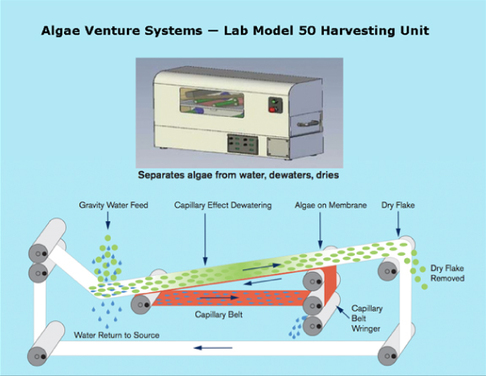Novel Techniques
Magnetic Separation
What appears to be a low-cost and sustainable algal harvesting method is being researched: Magnetic Seperation.
Xu et al. (2011) developed a method using nanoparticles for two types of microalgae, with a maximum recovery efficiency of over 98%. The nanoparticles can be recovered from the harvested microalgae for reuse. Another study (Cerff et al., 2012) highlighted the potential of silica-coated magnetic particles for algal removal, with separation efficiencies of over 95%. Both papers acknowledge the requirement of appropriate pH levels which aid the auto-flocculation, which may be hard to control in open, environmental systems.
Algaeventure Systems
Algaeventure Systems (2012) claim to have developed a system of solid-liquid separation (SLS) which requires around 94% less energy than a centrifuge. The cost is given as $1.92/ton, compared with $3,400/ton for centrifugation – however, it is unclear how these values were determined, and we believe it is unlikely to take into account costs from transportation of biomass.
More information below, including a diagram of processes from Algaeventure Systems:
What appears to be a low-cost and sustainable algal harvesting method is being researched: Magnetic Seperation.
Xu et al. (2011) developed a method using nanoparticles for two types of microalgae, with a maximum recovery efficiency of over 98%. The nanoparticles can be recovered from the harvested microalgae for reuse. Another study (Cerff et al., 2012) highlighted the potential of silica-coated magnetic particles for algal removal, with separation efficiencies of over 95%. Both papers acknowledge the requirement of appropriate pH levels which aid the auto-flocculation, which may be hard to control in open, environmental systems.
Algaeventure Systems
Algaeventure Systems (2012) claim to have developed a system of solid-liquid separation (SLS) which requires around 94% less energy than a centrifuge. The cost is given as $1.92/ton, compared with $3,400/ton for centrifugation – however, it is unclear how these values were determined, and we believe it is unlikely to take into account costs from transportation of biomass.
More information below, including a diagram of processes from Algaeventure Systems:


